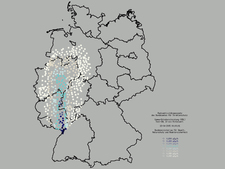-
Topics
subnavigation
Topics
Electromagnetic fields
- What are electromagnetic fields?
- Static and low-frequency fields
- Radiation protection relating to the expansion of the national grid
- High-frequency fields
- Radiation protection in mobile communication
Optical radiation
Ionising radiation
- What is ionising radiation?
- Radioactivity in the environment
- Applications in medicine
- Applications in daily life and in technology
- Effects
- What are the effects of radiation?
- Effects of selected radioactive materials
- Consequences of a radiation accident
- Cancer and leukaemia
- Genetic radiation effects
- Individual radiosensitivity
- Epidemiology of radiation-induced diseases
- Ionising radiation: positive effects?
- Risk estimation and assessment
- Radiation protection
- Nuclear accident management
- Service offers
-
The BfS
subnavigation
The BfS
- About us
- Science and research
- Laws and regulations
- BfS Topics in the Bundestag
- Links
Emergency measuring strategies
To characterise the current radiological situation, comprehensive measurements according to the intensive measurement programme are instantly performed in emergency situations.

![]() Simulated snap-shot of the ambient dose rate during the dispersion of a radioactive cloud; during intense operation, the ambient dose rate (ODL) measuring system provides net depictions every ten minutes
Simulated snap-shot of the ambient dose rate during the dispersion of a radioactive cloud; during intense operation, the ambient dose rate (ODL) measuring system provides net depictions every ten minutes
During the passing of a radioactive cloud: Monitoring networks
The most important tools during the passing of a radioactive cloud are the automatic monitoring networks
- of the Federal Office for Radiation Protection (used to assess the external radiation exposure (ambient dose rate) and
- of the German Weather Service (DWD; used to determine the nuclide-specific radionuclide concentration in the air).
In the event of an accident, the ambient dose rate measurement results are retrieved every ten minutes from approximately 1,800 sites. Thus, the dispersion of a radioactive toxic cloud can be followed, as it were, online, and the affected areas can be narrowed down very soon (compare picture - in Geman only).
In parallel, the 50 stations of the German Weather Service’s air monitoring network provide the nuclide-specific aerial activity every two hours. Both measurements are the basis for the prognostic estimation of external radiation exposure and inhalation dose which is the base for the decisions relevant in early stages (concerning the measures evacuation, staying in the house and taking of iodine pills).
After the passing of the cloud: Deposition on the ground
After the passing of the cloud, maps must be compiled showing the environmental contamination. The maps must be usable for optimizing later measurement and action strategies. Particularly the ambient dose rate and in-situ-measurements which help to analyse the extent of radionuclide deposition on the ground, are used to draw up these maps. For measuring non-homogeneous depositions in small areas, mobile units (helicopters, measuring vehicles) are available.
Measurements focus on agricultural products
After the radioactive cloud has passed, a main focus is on the marketability of foodstuffs. The measuring activities of the Laender will therefore concentrate on the representative environmental media leaf vegetables, milk and grass. After that, the focus will be on products which are ripe for harvesting. These measurements will be consolidated in areas where the activities are in the range of the European Union's dose limit values.
The intensive measuring programme gradually evolves back into the routine measurement programme again. The frequency and duration of intensive sampling and measurements in the respective media however, follows the
- manner and dynamics of the respective dispersion and
- enrichment processes.
During this phase, intensive measurements are still performed in areas where increased activity concentrations can still occur, such as for example milk in the event of a winter feed with contaminated hay.
State of 2016.11.03


